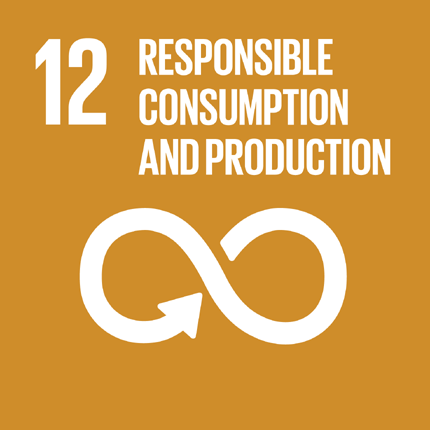sdg12
SUSTAINABLE DEVELOPMENT GOAL 12
Ensure sustainable consumption and production patterns
Progress of goal 12
- Economic growth and development require the production of goods and services that improve the quality of life. Sustainable growth and development require minimizing the natural resources and toxic materials used, and the waste and pollutants generated, throughout the entire production and consumption process.
- Two measures, material footprint and domestic material consumption, provide an accounting of global material extraction and use, as well as flows or consumption of materials in countries. The material footprint reflects the amount of primary materials required to meet a country’s needs. It is an indicator of the material standard of living or level of capitalization of an economy. Domestic material consumption measures the amount of natural resources used in economic processes.
- In 2010, the total material footprint in developed regions was significantly higher than that of developing regions, 23.6 kg per unit of GDP versus 14.5 kg per unit of GDP, respectively. The material footprint of developing regions increased from 2000 to 2010, with non-metallic minerals showing the largest increase.
- Domestic material consumption in developed regions has diminished slightly, from 17.5 tonnes per capita in 2000 to 15.3 tonnes per capita in 2010. It remains significantly higher than the value for developing regions, which stood at 8.9 tonnes per capita in 2010. Domestic material consumption per capita increased in almost all developing regions from 2000 to 2010, except in Africa, where it remained relatively stable (around 4 tonnes per capita), and Oceania, where it decreased from around 10.7 to 7.7 tonnes per capita. The rise in domestic material consumption per capita in Asia during that period is primarily a result of rapid industrialization.
- The Basel Convention on the Control of Transboundary Movements of Hazardous Wastes and Their Disposal, the Rotterdam Convention on the Prior Informed Consent Procedure for Certain Hazardous Chemicals and Pesticides in International Trade and the Stockholm Convention on Persistent Organic Pollutants established international frameworks to achieve the environmentally sound management of hazardous wastes, chemicals and persistent organic pollutants. With six exceptions, all Member States are party to at least one of those conventions. The number of parties to those conventions rose significantly from 2005 to 2015, particularly in Africa and Oceania. There are now 183 parties to the Basel Convention, 180 to the Stockholm Convention and 155 to the Rotterdam Convention.
Source: United Nations, Department of Economic and Social Affairs, SUSTAINABLE DEVELOPMENT KNOWLEDGE PLATFORM
The National Indicators for Sustainable Development Goal 12 are:
- Domestic material consumption, domestic material consumption per capita, and domestic material consumption per GDP (thousand tonnes)
- Average CO2 emissions per km from new passenger cars
- Generation of waste excluding major mineral wastes by hazardousness ( in Kilograms per capital)
All available data in .xls file:
- Responsible consumption and production
Last Updated: 25/4/2025
EU SDG indicator set
To measure SDG achievement in an EU context, an EU SDG indicator set was developed under the leadership of Eurostat. The purpose of this set, which is structured along the 17 global Sustainable Development Goals, is to monitor progress towards the SDGs at the European level.
- For the complete set of indicators available in the Eurostat database, click here.
- To compare Greece’s progress on specific indicators for each Sustainable Development Goal, click here [data visualisation].

